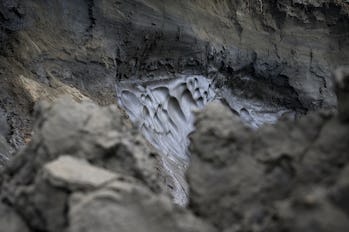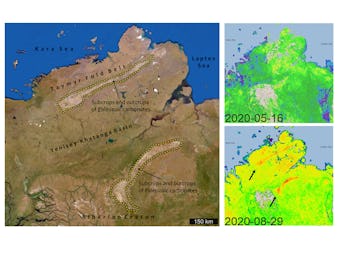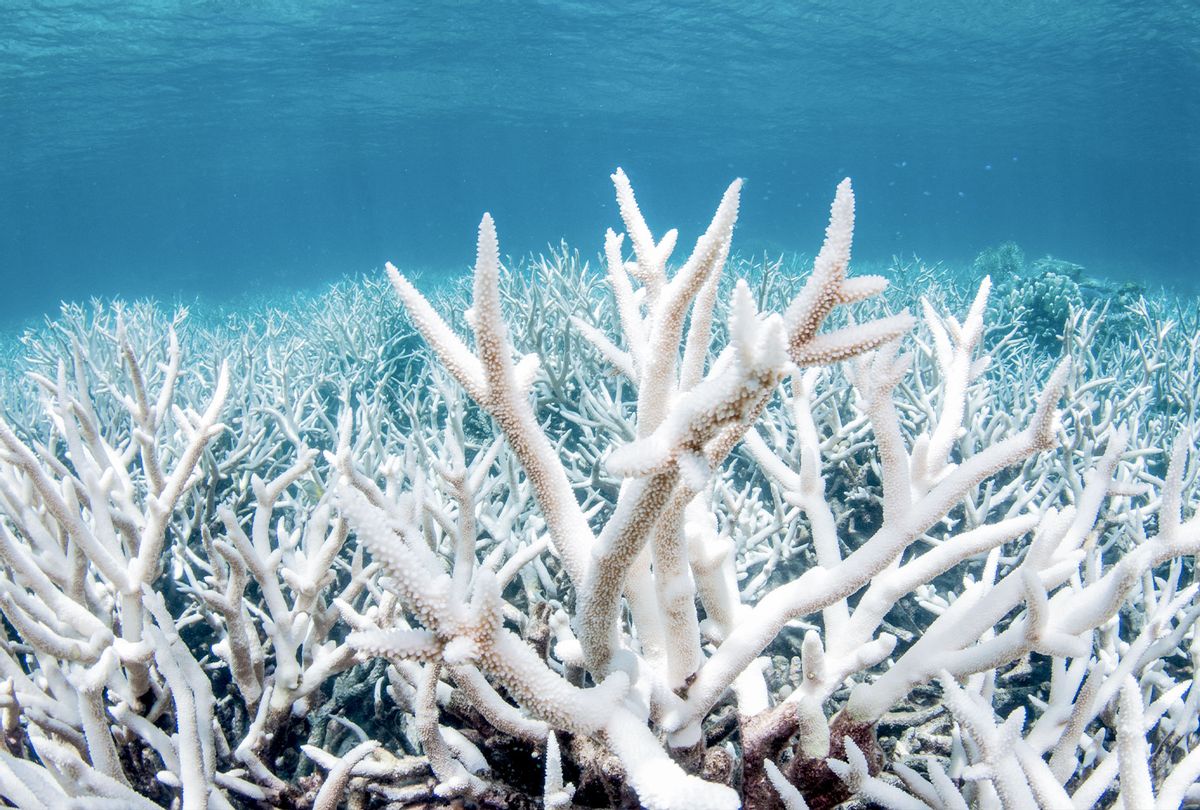
PLANET IN PERIL
SATELLITE IMAGES REVEAL A CLIMATE CRISIS NIGHTMARE IN SIBERIA
Understanding this study’s findings “may make the difference between catastrophe and apocalypse.”
Dimitar Dilkoff/Getty Images
TARA YARLAGADDA
TRAVERSE DEEP INTO NORTHERN SIBERIA, and you’ll find the Yenisey-Khatanga Basin. As of late, this remote part of the world is predominantly known for two things: its untapped potential as a massive source of oil and gas, and its proximity to the wildfires that have raged in Siberia this summer.
Now, scientists suggest another factor that demands our attention: According to a study published Monday in the journal Proceedings of the National Academy of Sciences, considerable amounts of methane are being released from a previously unexplored source.
Arctic methane is typically connected to two sources: organic matter in permafrost and methyl clathrate (molecules of methane frozen in ice crystals). This study spotlights a third — one released from fractures and pockets in the permafrost zone that’s become unstable due to warming.
As the climate crisis worsens, understanding this study’s findings “may make the difference between catastrophe and apocalypse,” lead author Nikolaus Froitzheim, a professor at the University of Bonn’s Institute of Geosciences in Germany, tells Inverse.

Permafrost melts into the Kolyma River in Siberia during July 2019. Record-breaking heat waves increase permafrost thaw, triggering the release of methane and contributing to global warming. Getty
WHAT YOU NEED TO KNOW FIRST — The thawing of the Siberian permafrost — a mixture of rock, ice, soil, and the organic remains of animals and plants — is associated with the release of methane in the atmosphere. Global warming has led to an increased thawing of the permafrost.
Methane is a potent greenhouse gas emission with 84 to 86 times the warming power of carbon dioxide over a 20-year period.
After conducting a satellite analysis of the Yenisey-Khatanga Basin, Froitzheim and colleagues found we’ve been overlooking another crucial source of methane emissions from the Siberian permafrost: sites of “thermogenic methane.”
HOW THE DISCOVERY WAS MADE— The researchers used an interactive satellite mapping technology, known as PULSE, to calculate methane emissions in the air above the Yenisey-Khatanga Basin in Siberia.
“THERE IS A LOT OF NATURAL GAS IN THE SUBSURFACE OF SIBERIA.”
The researchers looked specifically at methane emissions following a heat wave in Siberia in June 2020, as well as methane emissions in the area in spring 2021. They also compared the methane emissions on the satellite map to a geological map showing where certain rock formations occur.
The researchers then made an alarming discovery:
“We found that two elongated areas of elevated methane concentration on the PULSE map perfectly coincide with two stripes where limestone formations occur in the subsurface,” Froitzheim says.

Satellite imagery shows atmospheric methane concentrations during May and August 2020 over the Taymyr Peninsula in Northern Siberia. Nikolaus Froitzheim, Dmitry Zastrozhnov, and GHGSAT.
WHAT’S NEW — Those limestone formations are likely sites of “thermogenic methane” or natural gas deposits of methane hidden deep underneath the permafrost. Natural gas, the team writes, can be “trapped under or within the permafrost layer and released when it thaws.”
The methane couldn’t have come from the usual microbes breaking down organic matter in the soil, since there is very little soil in these limestone formations.
HEAT “MADE THIS MIXTURE UNSTABLE AND OPENED PATHWAYS.”
Instead, Frotzheim suspects record-breaking temperatures disturbed fractures in the limestone, providing an opportunity for natural gas from deeper within the permafrost to escape into the atmosphere.
“Our hypothesis is that the heat made this mixture unstable and opened pathways through which natural gas from depth could reach the surface,” Frotzheim says. “There is a lot of natural gas in the subsurface of Siberia, and some of these reservoirs may have been tapped.”
Comparing maps over a one-year period between May 2020 and May 2021, the scientists found that “atmospheric methane concentrations have increased considerably during and after the 2020 heat wave.”
“After” is key: The increase in methane was highest in June/August 2020 as well as in March/April 2021, demonstrating how warming can trigger methane release long after the initial heat wave.
WHY IT MATTERS — The events in Northern Siberia are all, in a way, connected: the fires, the hunt for natural fuel, and the release of a powerful greenhouse gas.
Methane traps heat in the atmosphere and plays a major role in climate change. The heat wave that ignited Siberia’s wildfires is part of a trend driven by human-induced climate change — so is the thawing of Siberia’s permafrost. The extraction of oil and gas also releases methane. These factors are all connected.
It’s a domino effect that doesn’t appear to be slowing down: Record-breaking temperatures hit Siberia in 2020 and once again in the summer of 2021.

In July 2021, a couple attempts to evade smoke hanging over the city of Yakutsk, in Siberia. Dimitar Dilkoff/Getty Images
As temperatures continue to skyrocket due to the climate crisis, the permafrost thaw may unleash unknown quantities of this deep methane gas into the atmosphere. In 2018, NASA predicted a possible “future boost” of methane from Arctic permafrost — that prediction is coming true.
Based on their findings, the researchers conclude: “As a result, the permafrost–methane feedback may be much more dangerous than suggested by studies accounting for microbial methane alone.”
WHAT’S NEXT — Methane may be coming from deep within the Siberian ice, but scientists are still scratching the surface of permafrost research.
Froitzheim and his colleagues still aren’t sure why methane emissions began spiking more than half a year after the summer 2020 heat wave.
The team calls on more scientists to conduct research to “find out how fast and how much methane may be emitted this way,” including an analysis of methane in air samples and calculations of methane gas destabilization in the rocks.
While these measures are a way for scientists to better understand the exact amount of methane released due to permafrost, they’re not a solution.
These findings don’t necessarily mean the permafrost is beyond repair, the scientists suggest. The amount of methane being released from these deep methane reserves are relatively small compared to, say oilfields in Libya or wetlands in India, Froitzheim says. To have any chance of halting the release of methane from the permafrost we need to immediately begin reducing greenhouse gas emissions from fossil fuels and other industries.
“I do not think that these particular observations mean that we have passed a point of no return,” Frotzheim says.
Abstract:
Edited by Thure E. Cerling, The University of Utah, Salt Lake City, UT, and approved July 2, 2021 (received for review April 22, 2021)
Abstract
Anthropogenic global warming may be accelerated by a positive feedback from the mobilization of methane from thawing Arctic permafrost. There are large uncertainties about the size of carbon stocks and the magnitude of possible methane emissions. Methane cannot only be produced from the microbial decay of organic matter within the thawing permafrost soils (microbial methane) but can also come from natural gas (thermogenic methane) trapped under or within the permafrost layer and released when it thaws. In the Taymyr Peninsula and surroundings in North Siberia, the area of the worldwide largest positive surface temperature anomaly for 2020, atmospheric methane concentrations have increased considerably during and after the 2020 heat wave. Two elongated areas of increased atmospheric methane concentration that appeared during summer coincide with two stripes of Paleozoic carbonates exposed at the southern and northern borders of the Yenisey-Khatanga Basin, a hydrocarbon-bearing sedimentary basin between the Siberian Craton to the south and the Taymyr Fold Belt to the north. Over the carbonates, soils are thin to nonexistent and wetlands are scarce. The maxima are thus unlikely to be caused by microbial methane from soils or wetlands. We suggest that gas hydrates in fractures and pockets of the carbonate rocks in the permafrost zone became unstable due to warming from the surface. This process may add unknown quantities of methane to the atmosphere in the near future.
In a warming world, the release of CO2 and methane from thawing permafrost to the atmosphere may lead to a positive feedback by increasing the concentration of greenhouse gases (1⇓–3). Methane is particularly critical because of its high global warming potential per mass unit. In review articles on this subject, the focus is mainly on organic matter stored in frozen soils and its microbial decay and release as microbial methane upon thawing (1⇓–3). However, thermogenic methane, i.e., natural gas from the deeper subsurface, may also contribute to the feedback. A proportion of thermogenic methane in addition to the dominant microbial methane was found in gas emission craters in Western Siberia (4). For the subsea permafrost in the East Siberian Arctic Shelf, it was argued that thawing can make the permafrost layer permeable for gas stored as hydrates or as free gas within the permafrost layer and also for subpermafrost gas (5). Isotopic signatures of methane released in the East Siberian Arctic Shelf are consistent with an origin as old, deep, and likely thermogenic methane (6).
In 2020, Siberia saw an extreme heat wave (7). The maximum of the annual surface temperature anomaly, of up to 6 °C above the 1979–2000 baseline, was located on the Taymyr Peninsula in North Siberia (https://climatereanalyzer.org/). The atmospheric concentrations of methane in northern Siberia show a marked increase since June 2020, revealed by the PULSE map of methane concentrations (https://pulse.ghgsat.com/). The increase was strongest in July/August 2020 and in March/April 2021. During summer, 2020, two conspicuous elongated areas of increased methane concentration (in the following: “elongated maxima”) appeared (Fig. 1), approximately parallel to each other, several hundred kilometers long, and trending SW–NE. In early 2021, methane concentration increased over the entire area. In the present communication, we demonstrate the geological significance of these maxima and discuss possible reasons for the increased methane concentrations, as well as consequences for the permafrost–methane feedback.
Atmospheric methane concentrations in North Siberia during 2020–2021, from PULSE map (https://pulse.ghgsat.com/). Note two elongated maxima of methane concentration (arrows) coinciding with carbonate outcrop areas (Fig. 2), and region-wide concentration increase in March to April 2021. See Fig. 2 for location. Curve shows monthly means of 2-m temperature in Siberia (55°N–76°N, 70°E–180°E) during the study period (https://climatereanalyzer.org/).
Results
The two elongated methane concentration maxima correlate well with two stripes characterized by outcrops and stone runs of carbonate rocks (Fig. 2). In these two areas, soil is thin to nonexistent, i.e., the carbonate rocks crop out at the surface, vegetation is scarce, and the proportion of wetlands is low. The northern lineament coincides with the Early Paleozoic Siberian passive-margin carbonate succession. The southern lineament mimics outcrops of Paleozoic carbonates covering the rim of the Siberian Craton. The area between the two lineaments is occupied by Late Paleozoic and Mesozoic, predominantly clastic sedimentary rocks of the Yenisey-Khatanga Basin (8). The region is underlain by continuous permafrost about 700 m thick in the Yenisey-Khatanga Basin (9).
Geology of the Taymyr Peninsula in North Siberia. (A) Satellite image (ArcGIS World Imagery). Carbonate rock formations on both sides of the Yenisey-Khatanga Basin visible as light-colored stripes. Outlines of atmospheric methane concentration anomalies (Fig. 1) indicated as yellow dashed lines. (B) Simplified geological map (modified from ref. 8). Note close coincidence of carbonate formations and methane anomalies.
We studied the evolution of methane concentrations using PULSE, an interactive map of atmospheric methane concentrations launched in 2020 and based on satellite spectroscopy. PULSE shows monthly concentration averages with a 2 × 2-km resolution. The map for a certain date shows concentration averaged over the preceding month. Absolute concentrations are only approximate, but spatial and temporal concentration gradients are well displayed. In May 2020, methane concentrations were low (∼1,800 ppb) and rather uniform in the area of interest. On June 26, near the climax of the heat wave (T curve in Fig. 1), the southern lineament was for the first time clearly visible as an elongated maximum in methane concentration.
In August, the southern maximum was strongest and the northern maximum appeared, and in the following became approximately as strong as the southern one. The situation remained unchanged until March 2021, when concentration started rising across the entire area and the two maxima partly disappeared in the increased background concentrations. On April 10, 2021, almost the entire area showed concentrations around 1,900 ppb. Comparison of the maps for May 16, 2020, and May 15, 2021, shows the significant increase of methane concentration within 1 y, focused on northern Siberia.
Discussion
The almost perfect coincidence between the stripes where carbonate rocks crop out and the elongated concentration maxima strongly suggests that the maxima result from geologically controlled methane emissions from the ground. These cannot represent microbial methane from the decay of soil organic matter because soils are thin to nonexistent, nor can they come from wetlands because there are relatively few wetlands on the carbonate rocks, nor from vegetation because there is hardly any. Consequently, the source must be thermogenic methane from the subsurface. The Paleozoic carbonates are potential hydrocarbon reservoir rocks (10). This opens the possibility that methane was emitted from gas stored in the carbonates, probably in the form of gas hydrate. The permafrost in North Siberia contains pockets and layers of gas hydrate, which have caused blowouts during drilling. Hydrates also exist metastably above the hydrate stability zone (11). The shallowest gas blowouts occurred at only 20-m depth (11). Eruption of gas from the mobilization of gas hydrates is assumed to have caused the formation of a gas eruption crater in the Patom hills, further south in Siberia but still in the permafrost zone (12). Importantly, this crater is on Neoproterozoic carbonate rocks, showing that the process of gas eruption does occur in carbonate rocks.
Ice-bonded permafrost is virtually impermeable for gases, leading to permafrost-capped gas reservoirs (9). In the hydrate stability zone, comprising the lower part of the permafrost and several 100 m below, methane and water form gas hydrate. Hydrates located above the present-day stability zone either formed due to ice load during glaciations, which raised the upper boundary of the stability zone to the ground surface, or because of a pressure increase due to freezing of water in pores and closed cavities (5, 11). We suggest that the mobilization of gas hydrate in fractures at shallow level, caused by warming from above during the heat wave, reduced the pressure on deeper gas hydrate, which was then mobilized, and so on, opening vents for increasingly deeper-seated gas. This process can occur in any fractured rock but is expected to be much faster in carbonate rocks, with their network of interconnected fractures and karst cavities, than in other rock types. This may explain why the maxima over the limestone appeared soon after the beginning of the heat wave. Rock composition may also play a role: Increased temperature in the gas-hydrate–hosting carbonates may mobilize hydrous fluid carrying dissolved CO2, which would cause CH4–CO2 replacement in analogy to the guest gas replacement technique applied to hydrate reservoirs, additionally speeding up the methane mobilization process.
The spring 2021 concentration increase is unusual because the area was still snow-covered and temperatures were low (curve in Fig. 1). Methane emissions during spring thaw are known from Arctic permafrost but these occur generally later, around end of May (13). The area of maximum spring 2021 concentration increase coincides with the maximum of 2020 temperature anomaly, i.e., the Taymyr Peninsula and surroundings, making a link between summer 2020 heat wave and spring 2021 methane emission plausible. The spring concentration increase, which is not restricted to the carbonates but occurred in the entire Yenisey-Khatanga Basin and surroundings, may at least partly also reflect gas hydrates from the permafrost. The reason for the delay of approximately half a year is unclear and requires further research.
To conclude, our observations hint at the possibility that permafrost thaw does not only release microbial methane from formerly frozen soils but also, and potentially in much higher amounts, thermogenic methane from reservoirs below and within the permafrost. As a result, the permafrost–methane feedback may be much more dangerous than suggested by studies accounting for microbial methane alone. Gas hydrates in Earth’s permafrost are estimated to contain 20 Gt of carbon (14). Additionally, subpermafrost natural gas reservoirs may be tapped. To clarify how fast methane from these sources can be transferred to the atmosphere, further research is urgently required, including monitoring of air composition, tracking of air movement, collection of air samples for analysis of tracers of thermogenic venting, and modeling of the hydrate destabilization process.
Materials and Methods
We used freely accessible online resources, the PULSE map for methane concentrations (https://pulse.ghgsat.com/) and the Climate Reanalyzer (https://climatereanalyzer.org/) for temperature and snow cover data.
Data Availability
All study data are included in the article and/or supporting information.
Acknowledgments
We thank the editors and two anonymous reviewers for constructive comments.
Footnotes
- ↵1To whom correspondence may be addressed. Email: niko.froitzheim@uni-bonn.de.
Author contributions: N.F. designed research; N.F., J.M., and D.Z. performed research; D.Z. analyzed data; and N.F. and J.M. wrote the paper.
The authors declare no competing interest.
- Copyright © 2021 the Author(s). Published by PNAS.
This open access article is distributed under Creative Commons Attribution-NonCommercial-NoDerivatives License 4.0 (CC BY-NC-ND).




.jpg?ext=.jpg) Seawater samples being taken near the Fukushima Daiichi plant (Image: IAEA)
Seawater samples being taken near the Fukushima Daiichi plant (Image: IAEA)